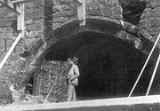
Hanging Bridge
Encyclopedia

River Irk
The River Irk is a river in Greater Manchester in North West England that flows through the northern suburbs of Manchester before merging with the River Irwell in Manchester city centre....
and Irwell
River Irwell
The River Irwell is a long river which flows through the Irwell Valley in the counties of Lancashire and Greater Manchester in North West England. The river's source is at Irwell Springs on Deerplay Moor, approximately north of Bacup, in the parish of Cliviger, Lancashire...
in Manchester
Manchester
Manchester is a city and metropolitan borough in Greater Manchester, England. According to the Office for National Statistics, the 2010 mid-year population estimate for Manchester was 498,800. Manchester lies within one of the UK's largest metropolitan areas, the metropolitan county of Greater...
, England. The first reference to the bridge was in 1343, when it was called Hengand Brigge, but the present structure was built in 1421, replacing an earlier bridge. Material taken from Manchester's Roman fort may have been used in its construction. It has been speculated that the Hanging Ditch may be of Roman origin, part of a defensive circuit between the rivers Irk and Irwell.
The name may derive from the Old English hen, meaning wild birds, and the Welsh
Welsh language
Welsh is a member of the Brythonic branch of the Celtic languages spoken natively in Wales, by some along the Welsh border in England, and in Y Wladfa...
gan, meaning between two hills. At its Irwell end, the Hanging Ditch was 120 feet (36.6 m) wide and 40 feet (12.2 m) deep. A stream flowed through the ditch, from the Irk to the Irwell possibly the lost River Dene, which gave its name to Deansgate
Deansgate
Deansgate is a main road through the city centre of Manchester, England. It runs roughly north–south in a near straight route through the western part of the city centre and is the longest road in the city centre at over one mile long....
. The bridge has two arches and was built using sandstone from Collyhurst
Collyhurst
Collyhurst is a locality in Manchester. It is 1½ miles northeast of Manchester city centre, on Rochdale Road and Oldham Road. The River Irk passes through the area...
. It is 108 feet (32.9 m) long and 9 feet (2.7 m) wide. Hanging Bridge formed part of Manchester’s medieval defences, when it was the main route from Manchester to the cathedral, then a parish church.
In 1600 the Hanging Ditch was condemned as an unsanitary open sewer, and in the following years the ditch was culverted and the bridge buried and built over. A directory published in 1772 recorded that nine houses had been built along the line of the bridge, suggesting that it may have been covered over during the first phase of Manchester's town planning, some time in the 1770s. The bridge was then forgotten, remembered only in the name of the area where it had stood, until its rediscovery and subsequent excavation as a result of demolition work carried out in the 1880s. The bridge was put on display, and in three months had about 32,000 paying visitors. It was once again covered up during the Victorian
Victorian era
The Victorian era of British history was the period of Queen Victoria's reign from 20 June 1837 until her death on 22 January 1901. It was a long period of peace, prosperity, refined sensibilities and national self-confidence...
expansion of Manchester. More than 100 years later it was uncovered again, and following restoration work it went on display in 2002 as a main attraction of Manchester Cathedral's newly built visitor centre.
Today the bridge is largely hidden by modern buildings, but it can be seen in the basement of Manchester Cathedral Visitor Centre, where it forms one side of the refectory. The bridge is listed as a Scheduled Ancient Monument
Scheduled Ancient Monument
In the United Kingdom, a scheduled monument is a 'nationally important' archaeological site or historic building, given protection against unauthorized change. The various pieces of legislation used for legally protecting heritage assets from damage and destruction are grouped under the term...
.

